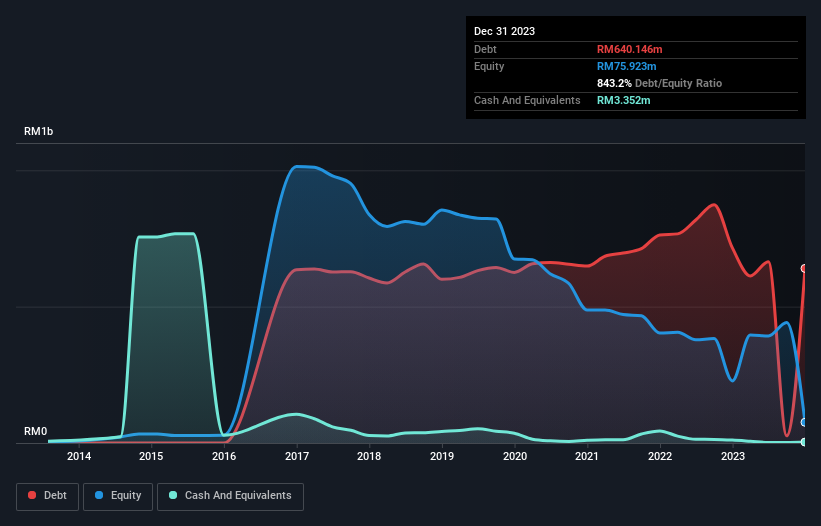
Warren Buffett famously said, 'Volatility is far from synonymous with risk.' So it seems the smart money knows that debt - which is usually involved in bankruptcies - is a very important factor, when you assess how risky a company is. As with many other companies Reach Energy Berhad (KLSE:REACH) makes use of debt. But the more important question is: how much risk is that debt creating?
When Is Debt Dangerous?
Debt and other liabilities become risky for a business when it cannot easily fulfill those obligations, either with free cash flow or by raising capital at an attractive price. Ultimately, if the company can't fulfill its legal obligations to repay debt, shareholders could walk away with nothing. While that is not too common, we often do see indebted companies permanently diluting shareholders because lenders force them to raise capital at a distressed price. By replacing dilution, though, debt can be an extremely good tool for businesses that need capital to invest in growth at high rates of return. The first thing to do when considering how much debt a business uses is to look at its cash and debt together.
Check out our latest analysis for Reach Energy Berhad
What Is Reach Energy Berhad's Debt?
You can click the graphic below for the historical numbers, but it shows that Reach Energy Berhad had RM640.1m of debt in December 2023, down from RM715.4m, one year before. And it doesn't have much cash, so its net debt is about the same.

How Healthy Is Reach Energy Berhad's Balance Sheet?
We can see from the most recent balance sheet that Reach Energy Berhad had liabilities of RM167.2m falling due within a year, and liabilities of RM648.5m due beyond that. Offsetting these obligations, it had cash of RM3.35m as well as receivables valued at RM311.0k due within 12 months. So its liabilities outweigh the sum of its cash and (near-term) receivables by RM812.0m.
This deficit casts a shadow over the RM53.2m company, like a colossus towering over mere mortals. So we'd watch its balance sheet closely, without a doubt. After all, Reach Energy Berhad would likely require a major re-capitalisation if it had to pay its creditors today. The balance sheet is clearly the area to focus on when you are analysing debt. But it is Reach Energy Berhad's earnings that will influence how the balance sheet holds up in the future. So when considering debt, it's definitely worth looking at the earnings trend. Click here for an interactive snapshot.
In the last year Reach Energy Berhad wasn't profitable at an EBIT level, but managed to grow its revenue by 23%, to RM209m. Shareholders probably have their fingers crossed that it can grow its way to profits.
Caveat Emptor
While we can certainly appreciate Reach Energy Berhad's revenue growth, its earnings before interest and tax (EBIT) loss is not ideal. Its EBIT loss was a whopping RM60m. When you combine this with the very significant balance sheet liabilities mentioned above, we are so wary of it that we are basically at a loss for the right words. Sure, the company might have a nice story about how they are going on to a brighter future. But the reality is that it is low on liquid assets relative to liabilities, and it lost RM197m in the last year. So we think buying this stock is risky. There's no doubt that we learn most about debt from the balance sheet. However, not all investment risk resides within the balance sheet - far from it. These risks can be hard to spot. Every company has them, and we've spotted 4 warning signs for Reach Energy Berhad (of which 3 don't sit too well with us!) you should know about.
Of course, if you're the type of investor who prefers buying stocks without the burden of debt, then don't hesitate to discover our exclusive list of net cash growth stocks, today.
New: AI Stock Screener & Alerts
Our new AI Stock Screener scans the market every day to uncover opportunities.
• Dividend Powerhouses (3%+ Yield)
• Undervalued Small Caps with Insider Buying
• High growth Tech and AI Companies
Or build your own from over 50 metrics.
Have feedback on this article? Concerned about the content? Get in touch with us directly. Alternatively, email editorial-team (at) simplywallst.com.
This article by Simply Wall St is general in nature. We provide commentary based on historical data and analyst forecasts only using an unbiased methodology and our articles are not intended to be financial advice. It does not constitute a recommendation to buy or sell any stock, and does not take account of your objectives, or your financial situation. We aim to bring you long-term focused analysis driven by fundamental data. Note that our analysis may not factor in the latest price-sensitive company announcements or qualitative material. Simply Wall St has no position in any stocks mentioned.
About KLSE:REACH
Reach Energy Berhad
An investment holding company, engages in the exploration, development, production, and sale of crude oil and other petroleum products in the Republic of Kazakhstan, Malaysia, and internationally.
Moderate and slightly overvalued.
Market Insights
Community Narratives



